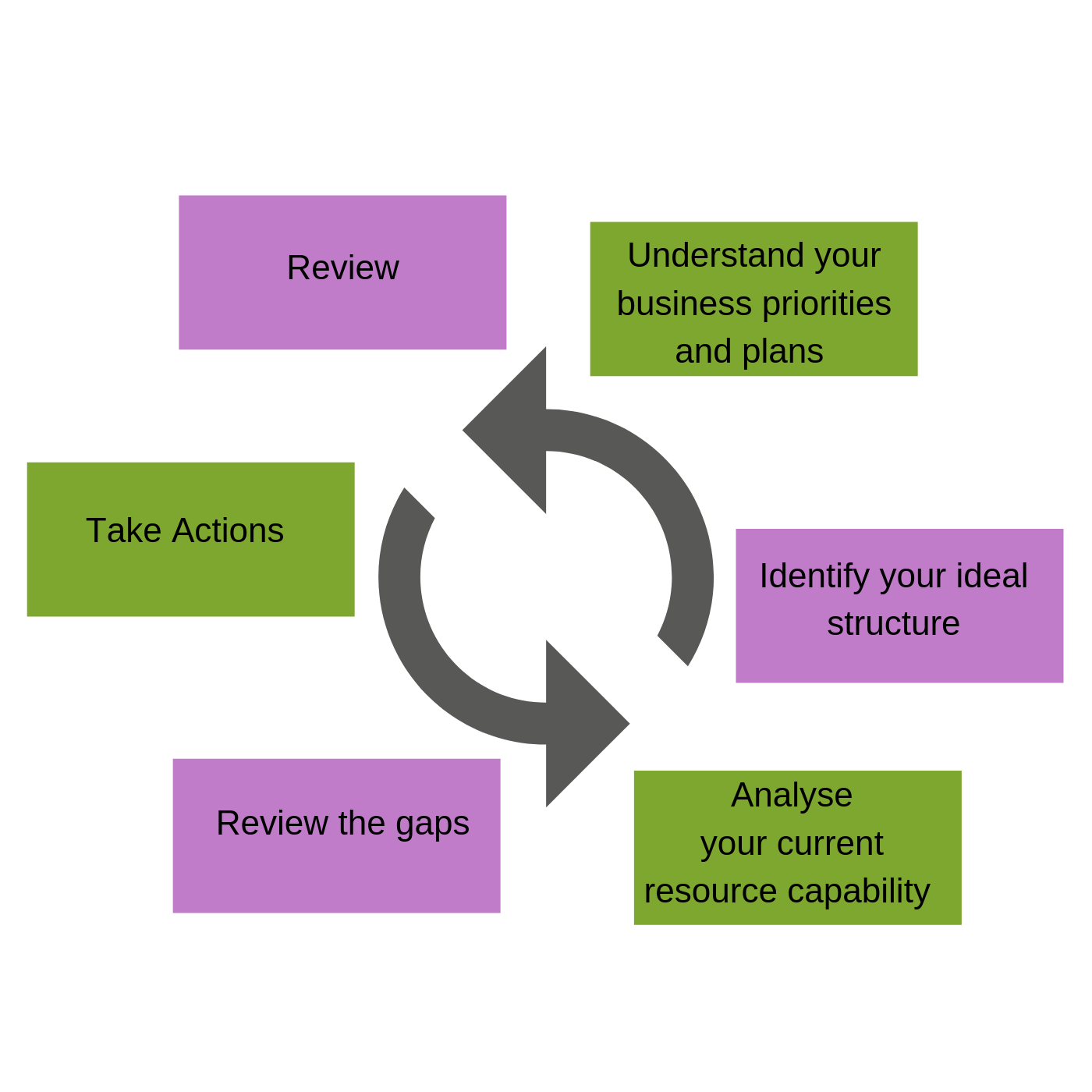10 tops tips for effective Workforce Planning
Nicole James • September 3, 2019
I once worked for a retail clothing business, which had a store on the beach in Newquay. The footfall changed with the weather – the store manager was excellent at roster management and would flex her staffing levels based on the sunshine. She’d developed great relationships with her team that meant they understood business needs and were in a position to offer flexibility. Hospitality, retail, leisure and contact centre environments are all good at looking at anticipated demand levels and flexing their staffing rotas as appropriate (in the short term at least).
Workforce planning on a long term basis is a little more challenging. There is an element of crystal ball gazing but it’s still possible. I worked with a Buying Director who had a team of about 120 employees. We developed an ideal structure – it was something we were never going to get to overnight but it meant we knew where we were trying to go. Every time someone left or moved roles we edged a little closer. We knew which roles could be challenging to fill and focused our energy on developing employees in these areas. The recruitment team knew which roles could be tricky and they could proactively talent bank external individuals before a vacancy came up.
Workforce planning is about planning for business change – whether that’s an increase/decrease in people required to do the work or a change in skill sets needed. The aim of workforce planning is to align your business needs with your people strategy. As Benjamin once said, “If you fail to plan, you are planning to fail”. The fundamentals of workforce planning are:
1. Understand your business priorities and plans
2. Identify your ideal structure – both headcount and skill sets
3. Analyse your current resource capability
4. Review the gaps and where challenges may exist. Understand where you may become over resourced or have changing needs
5. Take actions to address skills gaps, shortages and mismatches
6. Review and repeat

Effective workforce planning doesn’t need to be complex. Here are my top 10 tips for successful workforce planning:
1.
Understand your business
– if you’re working with an HR Consultant then transparency is key. Share your business strategy, work together to understand your ideal structures.
2. Look at short term and long term plans
- You need to be clear on your business priorities in the immediate future and the longer term. That doesn’t mean to say that things are set in stone. Plans can change.
3. Consider the different types of worker
- Don’t forget your workforce is made up of many different types of worker – gig economy, workers, contractors, freelancers, employees outsourcing etc. Factor this into your current workforce analysis and future ideal structures.
4. Go beyond headcount and budgets
– I’ve seen businesses claim they have a workforce plan when in reality they have a financial budget. Workforce planning is more than headcount and cost. You need to consider the skill sets required and the numbers of people with those skill sets that are required.
5. Use accurate and quality data –
you need to concentrate on the essential data needed for the task. It may be better to identify important business problems (such as expansion, downsizing or relocation) and work backwards from there as to what data is required to understand the resource implications. Inaccurate and poor-quality data will result in a half baked plan.
6. Factor in turnover –
Your employees aren’t frozen in time and some will choose to move on. You need to consider replacement of leavers as well as new roles and business changes. If you’re looking to downsize in future then don’t automatically backfill. Using attrition is a cost effective way to reduce your workforce overtime. It can also avoid the need to make redundancies.
7. Grow skills internally –
establishing succession plans, identifying skills gaps and training to meet future business needs will create a sustainable business. Growing talent internally is often cheaper than recruiting for talent externally.
8. Create Insights that inform and challenge assumptions – Share useful information with your leadership team. Challenge their thinking and help them to understand the role they play in delivering the plan. Communication with your leaders is critical to ensure effective delivery.
9. Practical actions –
a workforce plan is only useful if it’s followed and implemented. Make sure that you identify practical actions that will help you progress to your ideal structure.
10. Review regularly –
a workforce plan shouldn’t sit in the draw gathering dust. It should be reviewed each time a change takes place or your implementing something to ensure that you keep on track and no updates are needed.
In a nutshell, workforce planning will ensure that you have the right people, in the right roles, with the right skills, at the right cost and at the right time to deliver your business results. Have a chat with us about how we can support your business strategy by creating a workforce plan.

Big changes are coming for UK businesses with the introduction of the Employment Rights Bill. And the ones that prepare properly will have a significant advantage. Employment tribunal claims rose 23% last year. There are 45,000 open cases right now - a 32% increase on last year. The system is buckling under pressure. The heat is on employers to get people practices right and if they don't the commercial implications in terms of time and cost are significant. The Bill adds additional stress to businesses that are already finding it hard. But here's the good news: the government has given you more time to prepare. The biggest change - day-one unfair dismissal rights - won't kick in until 2027. The businesses that use this time to build proper people management systems will thrive. Those that don't will be at serious risk of costly claims and poor staff commitment. You have time to get this right. But only if you start acting now. The Numbers That Should Worry You 📈 Tribunal claims are exploding: Unfair dismissal: 22% of all claims Discrimination claims: 30% of total cases (up 15% in one quarter) Disability discrimination: up 28% in Q1 2025 alone Average unfair dismissal award: £13,749 💰 Immediate costs hitting now: National Insurance up from 13.8% to 15% Statutory sick pay rises to £118.75 per week New neonatal care leave: 12 weeks paid Fire and rehire failures: 25% compensation uplift (up to 112.5 days' pay) These aren't just statistics. They're real costs hitting real businesses right now. What Changes When (And Why It Matters) The government is taking a phased approach, with three key implementation dates: 📅 April 2026: Statutory Sick Pay reforms Protective awards double (90 to 180 days for collective redundancy breaches) Fair Work Agency established Day-one paternity and parental leave rights Trade union balloting changes 📅 October 2026: Fire and rehire restrictions Enhanced sexual harassment prevention duties Third-party harassment liability Extended tribunal claim time limits Stronger union rights and tips laws 🚨 2027 - The Big One: Day-one unfair dismissal rights Currently, employees need two years' service to claim unfair dismissal. From 2027, they can claim from day one. With unfair dismissal already representing 22% of all tribunal claims, expect this to explode. The smart businesses are using this extended timeline to build proper people management systems, not just fixing immediate problems. The People Problems You Need to Fix (But Now You Have Time to Do It Right) 🎯 Underperformers That team member who's been coasting for months? You don't need to panic, but you do need a plan. Use this time to implement proper performance management systems, not just quick fixes. ⏰ Attendance issues Persistent lateness or absence patterns? Build robust absence management procedures. You have time to do this properly, not reactively. 😤 Attitude problems Behavioural issues affecting the team? Address them systematically. Create clear behavioural expectations and consequences. 📝 Poor documentation If you can't prove your decisions were fair, you'll lose at tribunal. Use this extended timeline to build proper record-keeping systems. This isn't about rushing to fire people. It's about building systems that prevent problems and manage them fairly when they arise. Three Things You Should Start This Year 🔍 Build proper foundations Don't just patch problems - build systems. Review employment contracts, create comprehensive policies, and establish robust record-keeping. You have time to do this properly. 💪 Invest in manager development Train your managers in employment law basics, difficult conversations, and fair treatment principles. They're your first line of defence, and you now have time to develop their skills properly. 🎯 Create prevention systems Rather than just fixing current issues, build systems that prevent problems. Regular employee feedback, clear communication processes, and proactive performance management. The Business Case (It's Not Just About Compliance) Getting people management right isn't just about avoiding tribunals. Committed employees deliver: 21% higher profitability 10% increase in customer satisfaction 20% increase in sales Poor people practices cost you: Management time lost to tribunal proceedings (average 4.8 weeks per claim) Reputational damage High turnover costs Reduced productivity from everyone else The Reality Check The employment law landscape is changing, but you have more time than originally thought to prepare properly. Day-one unfair dismissal rights don't come in until 2027. But don't waste this opportunity. The businesses that use this time wisely will have a significant competitive advantage. This isn't just about compliance. It's about building businesses that can attract, retain and motivate great people. The businesses that will succeed are those that see these changes as an opportunity to professionalise their people practices. You have time to get this right. But only if you start building proper systems now, not waiting until 2026 to panic. The question isn't whether you can afford to invest in better people management. It's whether you can afford not to. While others wait until the last minute, smart businesses are already building the people practices that will give them competitive advantage in the new employment landscape. Don't waste the extra time you've been given. Need help building robust people management systems? The businesses that start now will be way ahead of those that wait until the last minute. Need help preparing for the changes ahead? The businesses that act now will have a significant advantage over those that wait until 2026.









